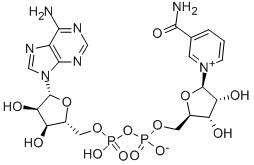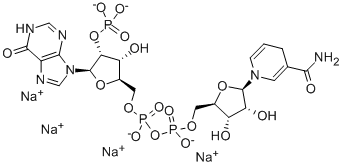Thionicotinamide adenine dinucleotide
Synonym(s):Thionicotinamide-DPN
- CAS NO.:4090-29-3
- Empirical Formula: C21H27N7O13P2S
- Molecular Weight: 679.49
- MDL number: MFCD00079609
- EINECS: 223-828-6
- SAFETY DATA SHEET (SDS)
- Update Date: 2025-08-21 11:10:19

What is Thionicotinamide adenine dinucleotide?
Description
Thionicotinamide adenine dinucleotide is an analog of NAD. Use of Thio-NAD instead of NAD as a substrate for NAD(+)-consuming enzymes is more advantageous since the reduced form of Thio-NAD exhibits a substantial increase in absorbance at 405 nM, the most commonly available wavelength on microplate readers.
Chemical properties
Light yellow powder
The Uses of Thionicotinamide adenine dinucleotide
Thionicotinamide adenine dinucleotide has been used as a substrate analog in S-adenosyl-l-homocysteine (AdoHcy) hydrolases (SAHH) inhibition assay and in NAD+ glycohydrolase activity.
What are the applications of Application
Thionicotinamide adenine dinucleotide (thio-NAD) is a NAD derivative used in the determination of Carnitine by an enzymic cycling method with carnitine dehydrogenase.
Biochem/physiol Actions
Thionicotinamide adenine dinucleotide (sNAD) is an analog of coenzyme nicotinamide adenine dinucleotide (NAD) and NADH. sNAD is a potential inhibitor of NAD+ kinase. NAD+ kinase modulates NAD levels, contributing to cytotoxicity in cancer cells.
Storage
Transport product sealed, dry, and protected from light at ambient temperature. Store product dry and protected from light. For long term storage keep below -20℃.
Properties of Thionicotinamide adenine dinucleotide
| storage temp. | -20°C |
| form | powder to crystal |
| color | Light orange to Yellow to Green |
| CAS DataBase Reference | 4090-29-3 |
Safety information for Thionicotinamide adenine dinucleotide
| Signal word | Warning |
| Pictogram(s) |
 Exclamation Mark Irritant GHS07 |
| GHS Hazard Statements |
H315:Skin corrosion/irritation H319:Serious eye damage/eye irritation H335:Specific target organ toxicity, single exposure;Respiratory tract irritation |
| Precautionary Statement Codes |
P271:Use only outdoors or in a well-ventilated area. P280:Wear protective gloves/protective clothing/eye protection/face protection. |
Computed Descriptors for Thionicotinamide adenine dinucleotide
| InChIKey | DQRRIGAXTAXHLR-NNYOXOHSSA-N |
| SMILES | O[C@@H]1[C@@H]([C@@H](COP(O)(=O)OP([O-])(=O)OC[C@@H]2[C@H]([C@@H](O)[C@H]([N+]3=CC=CC(C(=S)N)=C3)O2)O)O[C@H]1N1C=NC2C(=NC=NC1=2)N)O |&1:1,2,3,15,16,17,19,32,r| |
New Products
4,4-Difluoropiperidine hydrochloride tert-butyl 9-methoxy-3-azaspiro[5.5]undecane-3-carboxylate Indole Methyl Resin N-Isopropylurea N,N-Dicyclohexylcarbodiimide(DCC) MELDRUMS ACID 5-METHYLISOXAZOLE-4-CARBOXYLIC ACID Magnessium Bis glycinate Zinc ascorbate 1-bromo-2-butyne 2-acetamidophenol 9(10H)-anthracenone Erythrosin B, 4-Piperidinopiperidine 2-((4-morpholinophenylamino) (methylthio) methylene) malononitrile 2,4-dihydroxybenzaldehyde 3-(4-morpholinophenylamino)-5-amino-1H-pyrazole-4-carbonitrile Methyl 2-methylquinoline-6-carboxylate 2,6-dichloro-4-nitropyridine 4-Bromo-2-chlorobenzonitrile 2-(benzylamino)acetic acid hydrochloride 4-(tert-Butoxycarbonylamino)but- 2-ynoic acid 3,4-dihydro-2H-benzo[b][1,4]dioxepine 1-Phenyl-1-cycloprppanecarboxylicacidRelated products of tetrahydrofuran








You may like
-
 Thionicotinamide Adenine Dinucleotide (Thio-NAD) extrapure CAS 4090-29-3View Details
Thionicotinamide Adenine Dinucleotide (Thio-NAD) extrapure CAS 4090-29-3View Details
4090-29-3 -
 Thionicotinamide adenine dinucleotide 95% CAS 4090-29-3View Details
Thionicotinamide adenine dinucleotide 95% CAS 4090-29-3View Details
4090-29-3 -
![Thionicotinamide Adenine Dinucleotide oxidized form [for Biochemical Research] CAS 4090-29-3](https://img.chemicalbook.in//Content/image/CP5.jpg) Thionicotinamide Adenine Dinucleotide oxidized form [for Biochemical Research] CAS 4090-29-3View Details
Thionicotinamide Adenine Dinucleotide oxidized form [for Biochemical Research] CAS 4090-29-3View Details
4090-29-3 -
 Thionicotinamide adenine dinucleotide CAS 4090-29-3View Details
Thionicotinamide adenine dinucleotide CAS 4090-29-3View Details
4090-29-3 -
 3-(4-amino-1-oxoisoindolin-2-yl)-1-methylpiperidine-2,6-dione 98%View Details
3-(4-amino-1-oxoisoindolin-2-yl)-1-methylpiperidine-2,6-dione 98%View Details -
 20677-73-0 (2,2-diethoxyethyl)methylamine 98%View Details
20677-73-0 (2,2-diethoxyethyl)methylamine 98%View Details
20677-73-0 -
 3-(4-(hydroxyamino)-1-oxoisoindolin-2-yl)piperidine-2,6-dione 98%View Details
3-(4-(hydroxyamino)-1-oxoisoindolin-2-yl)piperidine-2,6-dione 98%View Details -
 57381-49-4 2-bromo-4-chlorobenzonitrile 98%View Details
57381-49-4 2-bromo-4-chlorobenzonitrile 98%View Details
57381-49-4
